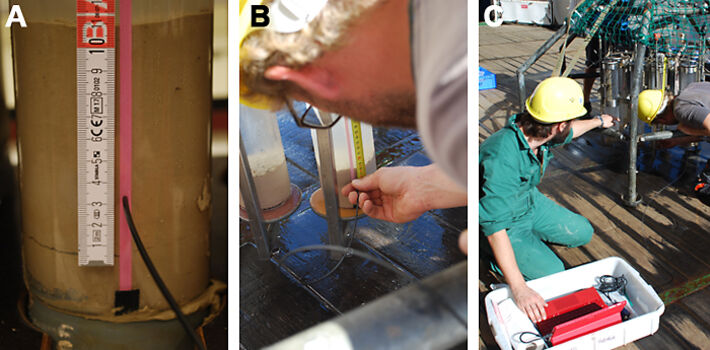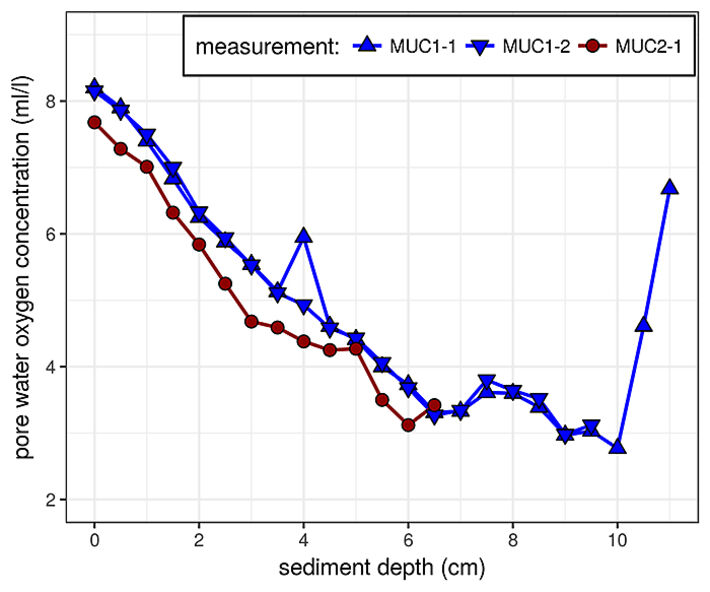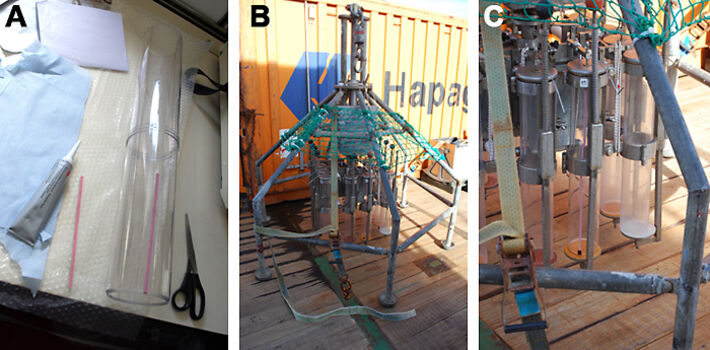Watch tutorials, webinars and informative videos about PreSens optical sensor systems.
Undisturbed Measurements of Oxygen in Deep Sea Sediments with Oxygen Sensitive Foil
The OXY-1 SMA system allows for fast measurements of pore water oxygenation in closed sediment cores
Patrick Blaser1, Jacek Raddatz2
1Institute of Earth Sciences, Heidelberg University, Heidelberg, Germany
2Insitute of Geosciences, Goethe University, Frankfurt, Germany
The transition from high to low and zero oxygen content in deep sea sediments provokes many important redox reactions in sedimentary pore waters, which are of high interest for geochemists. However, opening a sediment core yields the danger of introducing atmospheric O2, thus potentially compromising the measurements of pore water O2. Preparing a transparent sediment core with oxygen sensitive foils allows for fast and undisturbed measurements of the O2 content of sedimentary pore waters through the core wall once the core is recovered, but before atmospheric oxygen can exert an influence.
Deep sea sediments contain organic carbon, whose degradation by microbes decreases the oxygen content of the sedimentary pore waters. In most marine sediments, basically all oxygen is consumed within the upper 20 cm of the sediment column. This gradient in pore water O2 content causes many interesting reactions of diffusing ions in the pore waters in a small interval of the sediment column. Opening the sediment core for O2 measurements, however, can lead to contamination with atmospheric O2, compromising the measurements. In this study, we prepared the inside of one transparent 60 cm long core barrel with oxygen sensitive foil in order to measure the interface and pore water O2 contents immediately after core retrieval on deck of the research vessel. This method allows for fast and undisturbed determination of O2 contents in the pore waters.
Materials & Methods
We prepared one 60 cm long transparent core barrel from a 12 cores bearing multicorer (MUC) device with oxygen sensitive foil (SF-PSt3, PreSens) on the inside of the barrel (Fig. 1). We used three 20 cm long foils and attached them to the core wall with silicone glue more than one day before use, taking care that the individual stripes covered overlapping core intervals of about 2 cm each. Two MUC stations during cruise M151 with the research vessel Meteor in the central North Atlantic were carried out successfully at 1.5 and 2.7 km water depth with recoveries of 11 and 8 cm of sediment. Pore water salinity and temperature for measurement adjustments were assumed to be equal to those measured previously for ocean bottom water using a CTD (conductivity-temperature-depth) probe. For the first sediment core, oxygen was measured twice in the laboratory after the sediment core was capped with rubber plugs at top and base (Fig. 2 A). For the second sediment core, measurements were carried out immediately after securing the multicorer on deck and before any manipulation of the prepared core (Fig. 2 B+C); the measurement was then repeated in the laboratory after retrieving the core barrel from the device and capping the ends with rubber plugs. Measurements were carried out with an OXY-1 SMA oxygen meter (PreSens) with an optical fiber and depths were measured with a measuring tape from the sediment surface.

Results
Sediment core MUC1 was removed from the multicore frame and sealed with rubber plugs before pore water oxygen measurement in the ship laboratory. Two repeat measurement about ten minutes apart show excellent reproducibility except for one outlying data point at 4 cm depth. The measurements show that the bottom of the sediment got contaminated with atmospheric O2 during the removal of the core barrel from the corer frame, before the rubber plug could be attached. Therefore, the second core MUC2 was measured directly on deck before removal of the core barrel and its exposure to air. The results show that with this method contamination could be prevented. Unfortunately, both sediment cores were too short and too well oxygenated to retrieve anoxic sediment layers, but the steep gradient in oxygen content already shows the efficiency at which microbes consume the oxygen diffusing into the sediment from bottom waters.

Assessment of the Application
Preparing a transparent core barrel with the oxygen sensitive foil in order to measure the pore water oxygen content before any disturbance turned out to work very well, easy and fast. Thus, valuable information can be gathered immediately after retrieval of the sediment core in order to plan further sampling, sediment treatment, and ship time. The foil did not seem to be affected by the high pressure and deep sea environment and it did not seem to suffer from the insertion of the core barrel into the sediment, i.e. it did not unglue or break.
The most complicated part of the application was to fix the three foil stripes onto the inner wall of the core barrel without getting glue all over the stripes, which would probably prevent their proper functioning. Potentially a specially designed plastic rod could help attach the stripes to the smooth surface without slipping. Furthermore, during measurement it is important to direct the optical fiber at the center of the oxygen sensitive foil. A simple gadget for the horizontal fixation of the optical fiber, for example the Adapter for Round Containers ARC (PreSens) could be useful for easier measurement. Alternatively, a micromanipulator could be used for accurate positioning, but it would have to be tested whether its application would be feasible on deck of the research vessel. Finally, temperature of the pore water and oxygen sensitive foil are the most significant uncertainties. Combining the oxygen probe with optical temperature readings would be desirable for this kind of application because a temperature probe is impractical for temperature readings of the smooth outer core barrel wall. Optical temperature readings would allow for direct temperature compensation, assuming the pore water and oxygen sensitive foil have the same temperature as the core barrel, thus improving the accuracy of the oxygen readings.
The same method could also be carried out with smaller circular oxygen sensitive spots (SP-PSt3, PreSens) instead of stripes. The advantage would be lower cost and more exact depth positioning, but at a lower depth resolution. Furthermore, this method was also tested with a 'push core' - a small 20 cm long transparent core barrel that can directly be pushed into the sediment from a remotely operated vehicle (ROV). Unfortunately, during cruise M151 the ROV did not encounter sediments that were suited for push coring, but the general application looked promising.
Acknowledgements
We thank the chief scientist Prof. Norbert Frank and the captain and crew of the research vessel Meteor for the opportunity to test this method on cruise M151 during October 2018.



